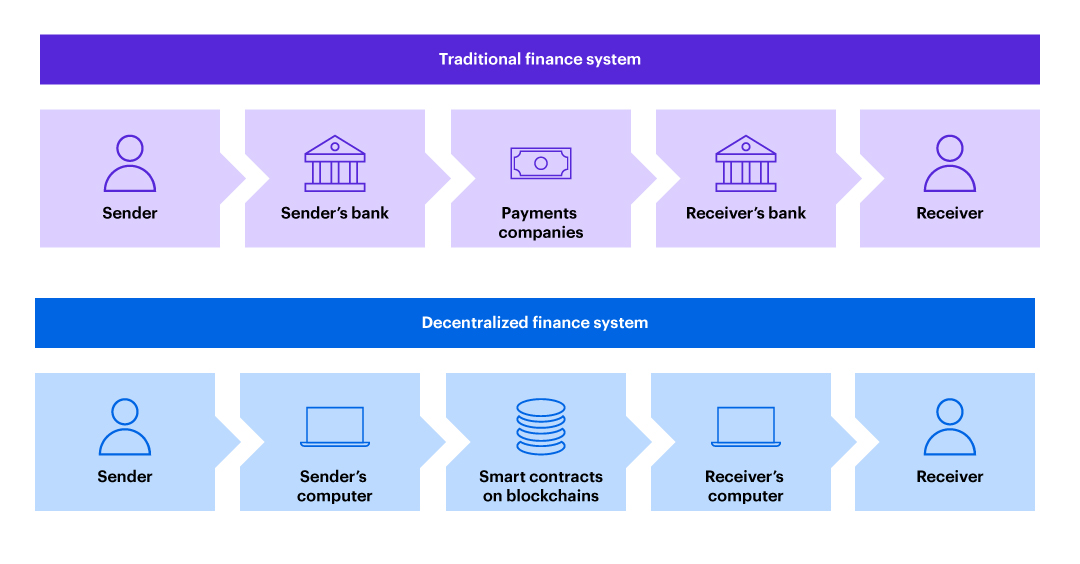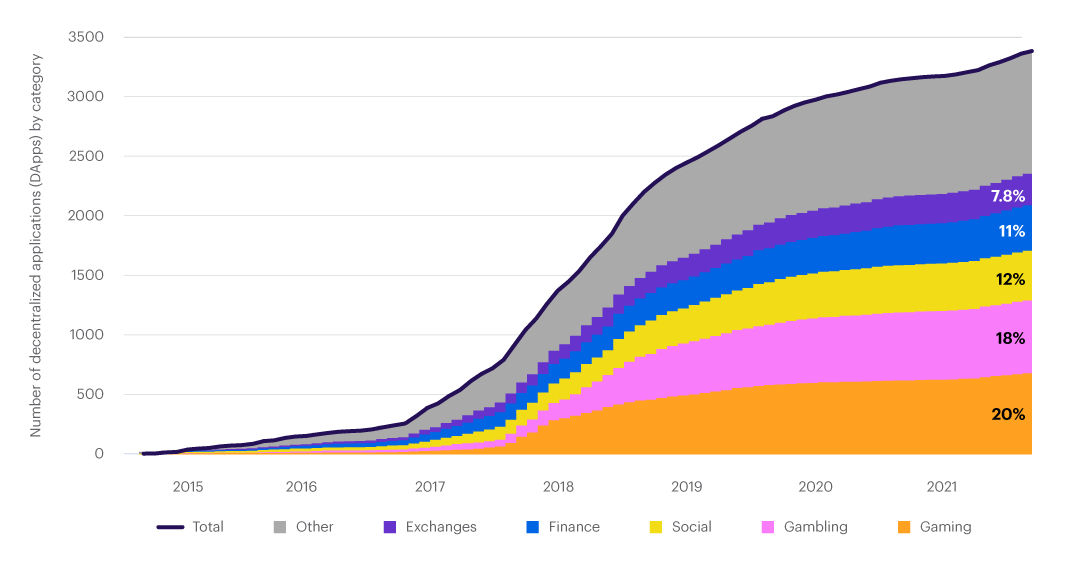Demystifying DeFi
Morgan Stanley Research
11/10/22Summary: Here’s what investors may want to know about the nascent technology that surrounds decentralized finance, and the investing landscape.

In the same way that cryptocurrencies have been viewed as an alternative to government fiat money, decentralized finance (DeFi) is viewed as an alternative to centralized financial systems (CeFi). To its proponents, DeFi is the future of finance, offering numerous ways to conduct transactions more efficiently and transparently than the traditional financial system.
The industry’s early growth was exponential: The total value of assets associated with DeFi systems grew over 300 times from nearly $600 million in 2020 to roughly $250 billion at the peak in December 2021.
However, DeFi has been mostly fueled by speculation at this stage, and the value of assets locked in DeFi has fallen drastically in 2022. The lack of regulation and risk of hacks and financial crimes may outweigh any evidence of its efficiency and effectiveness as a secure alternative.
Yet as cryptocurrency, blockchain, and related technologies evolve, questions about this nascent industry abound for many investors: What is DeFi? What are dApps? What factors have contributed to the industry’s rapid growth and can it continue? What opportunities are there to invest—and, importantly, what are the other key risks?
Below, Morgan Stanley’s Research team answers top investor questions about this emerging technology.
What is DeFi?
To start with the basics, DeFi is short for “decentralized finance,” which broadly refers to infrastructure, processes, and technologies that seek to replicate traditional financial services—but that use cryptocurrency and occur on a decentralized digital ledger known as a blockchain.
The “decentralized” part means that each participant on either side of a trade or transaction can interact directly from their computer to a program called a smart contract running on the blockchain that then interacts with another participant’s computer. A smart contract acts as intermediary, and every part of the transaction is logged on the blockchain.
In contrast, the traditional financial system operates on a centralized system where intermediaries like banks, exchanges, or payment processors manage the transactions.
Not all crypto businesses are decentralized. For example, Coinbase, one of the largest crypto exchanges, is a centralized business.
Decentralized finance digital asset transaction vs. traditional finance

Source: Morgan Stanley Research
What are some DeFi applications?
The world of DeFi comprises a wide array of decentralized applications, known as dApps, that are akin to traditional financial offerings. They can include cryptocurrency deposits and lending, exchanges for trading crypto assets, automated asset managers, and robo advisors. What’s more, dApps aren’t just made for the financial world; they can also be used for arts and collectibles in NFT marketplaces, for example.
All told, there are roughly 4,000 dApps listed on the State of DApps website, an online registry, with 40-50 added every month between August 2021 and May 2022. In 2022, new crypto wallets using decentralized platforms have been growing at a rate of over 100,000 per month.
Growth of decentralized applications by industry

Source: State of the DApps, Morgan Stanley Research
What factors have contributed to DeFi’s growth, and can it continue?
Central banks’ easing of financial conditions over the last few years caused investors to look for returns in new places, including DeFi, which had, during the crypto bull market, typically offered high yields and returns to help attract users. User growth, in turn, had made DeFi platforms more attractive to join, by increasing the number of people with whom one can potentially transact.
In a March 2022 report, Morgan Stanley Research analysts noted DeFi’s growth would likely slow and the industry may remain fairly small in the coming years, as regulatory scrutiny is likely to intensify and decentralized platforms add centralized controlled layers to attract users.
DeFi’s lack of processes to verify customer identities and prevent money laundering may limit institutional involvement, Morgan Stanley Research analysts say, and the need to establish these safeguards may ultimately force the industry to become more centralized. Consumer-protection regulations could further clamp down on retail involvement.
How can investors get exposure to DeFi?
While Morgan Stanley Research analysts don’t believe DeFi (in its pure decentralized form) will drastically alter the financial system as we know it, it’s hard to ignore the appeal it holds for some investors who understand the inherent risks. For those interested in DeFi, there are a few ways to gain exposure, including:
- Cryptocurrencies1—purchasing a coin associated with a blockchain that runs DeFi applications. Ethereum is the dominant blockchain used for decentralized applications, but there are many others. Buyers typically must have a crypto wallet to own and store the coin.
- Stocks associated with the DeFi ecosystem1—investing in companies that provide services in the industry, such as wallets, lending platforms, marketplaces, and blockchain technologies, although there are relatively few.
- Exchange-traded funds—exploring ETFs that invest in digital assets or stocks of companies involved in the DeFi space.
What are the risks?
Because of DeFi’s rapid growth and nascent technology, investing in the space may be especially risky. Investors should be aware of:
- Regulatory risk. The lack of regulation or oversight opens the door to financial crimes. Some DeFi applications have been, and can be, used to launder money.
- Market risk. The underlying assets tied to DeFi systems involve certain cryptocurrency tokens, which can be volatile.
- Concentration risk. Many cryptocurrencies have very concentrated ownership bases. Any movement in assets could affect crypto prices, as well as crypto-related investments.
- Technology risk. The hacking of DeFi platforms is also common. Transaction costs and fees vary from platform to platform, and there are even occasional coding errors within dApps.
- Encryption risk. If the technical processes that secure DeFi data and information (encryption) break, the system might not be usable until encryption is upgraded.
- Fraud risk. DeFi applications or platforms have been used by fraudsters to commit crypto scams, phishing campaigns, or other forms of fraudulent activity.
While these aren’t all the risks associated with investing in DeFi, investors who might be excited about the technology and its investment opportunities should do their research and consider whether opportunities in DeFi align with their near- or long-term financial goals.
The source of this article, “Decentralised Finance (DeFi): An Alternative Financial System?,” was originally published March 16, 2022.
- These assets may not currently be offered by E*TRADE. This information is provided for educational purposes only and not meant to be a recommendation to buy, sell, or transact in any security.